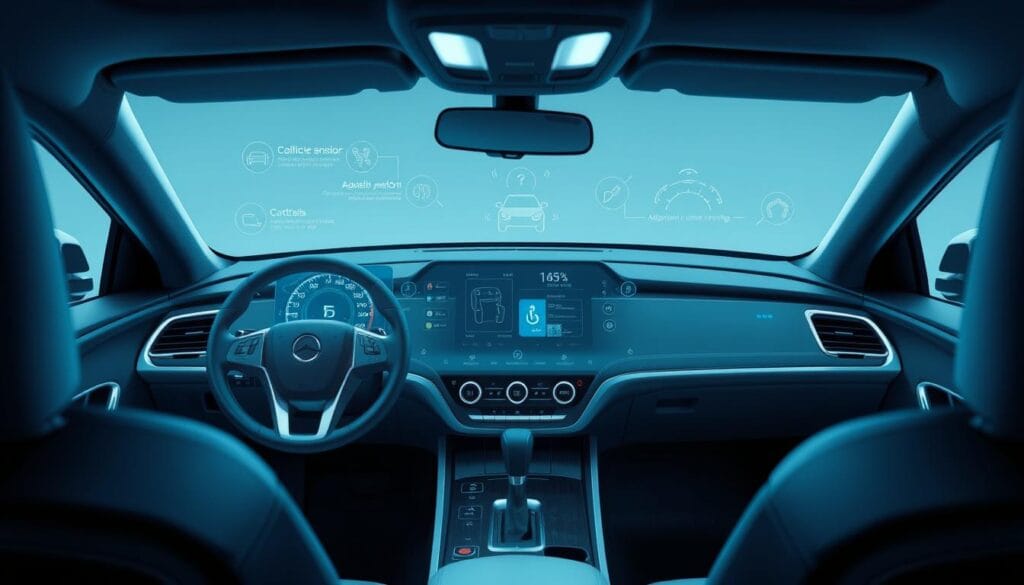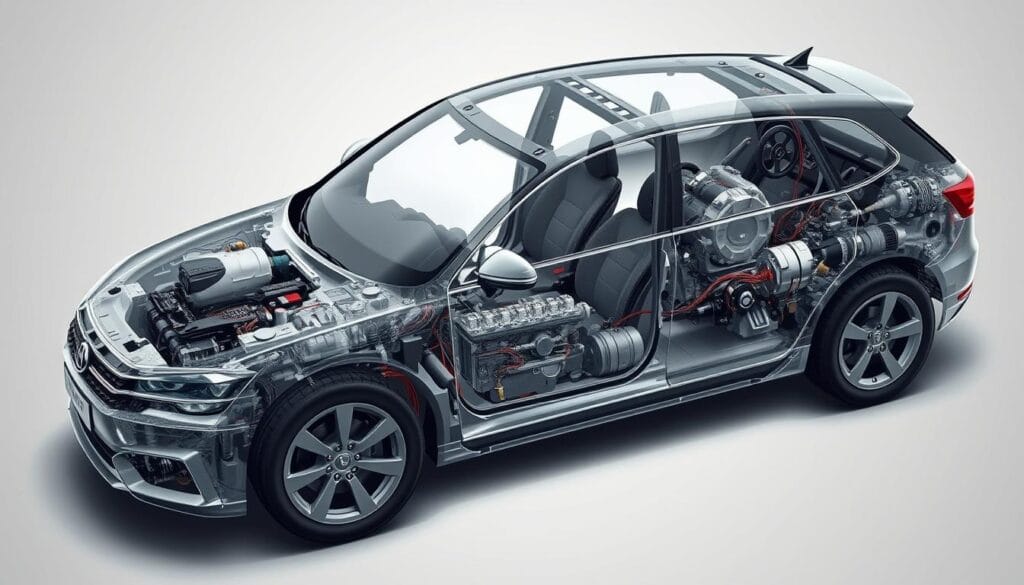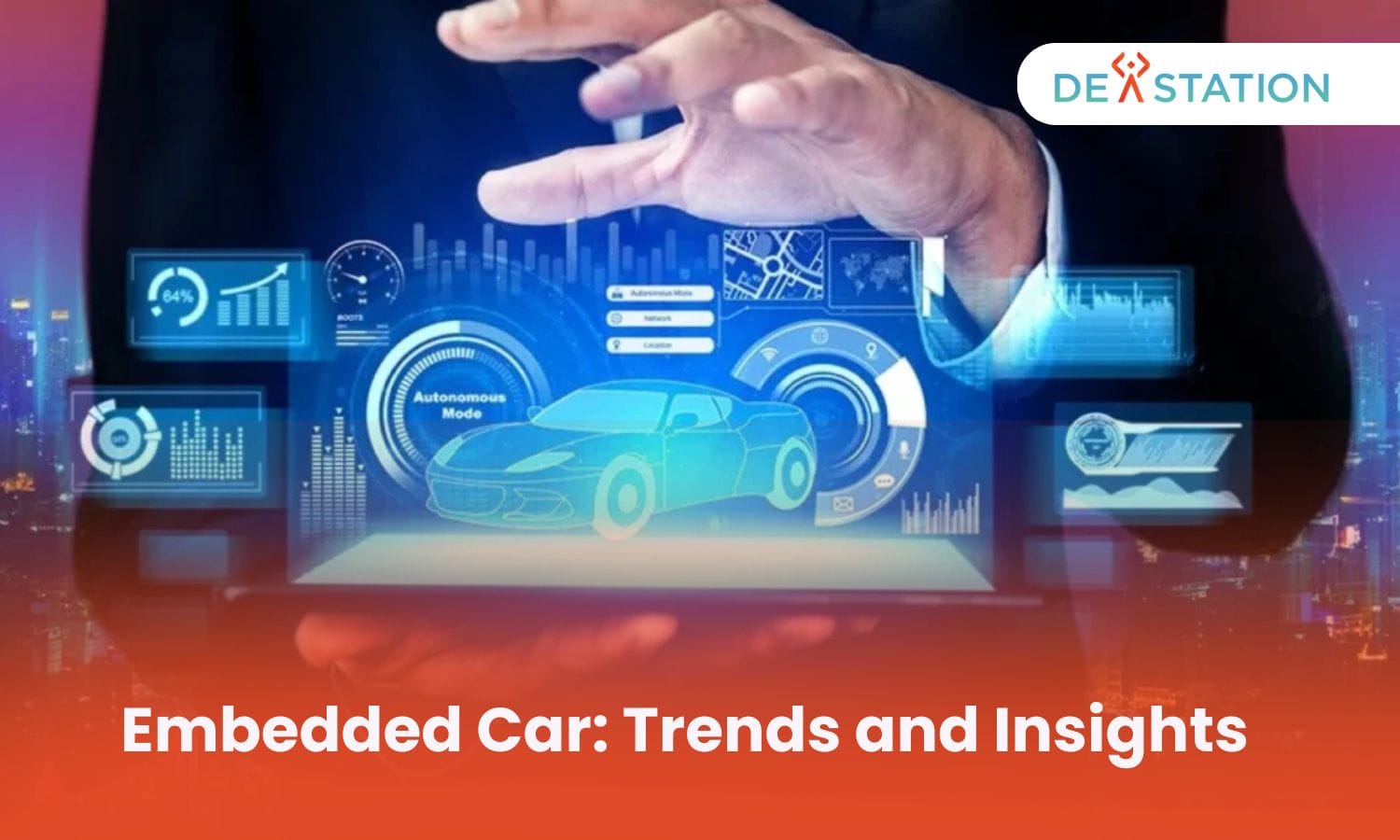Nearly 350 years ago, Ferdinand Verbiest designed the first self-propelled vehicle. Today, automobiles are faster, safer, and smarter than ever. This transformation relies on advanced systems that manage everything from engine performance to collision alerts.
Modern vehicles contain hundreds of electronic control units (ECUs) working in sync. These components process thousands of signals to optimize safety, fuel efficiency, and driver comfort. High-end models use over 100 interconnected ECUs powered by microcontrollers and programmable logic devices.
For business leaders and developers, understanding this technology is critical. It drives innovations like adaptive cruise control and real-time diagnostics. Organizations investing in automotive solutions must prioritize these intelligent frameworks to stay competitive.
This guide explores how these systems evolved from basic mechanical designs to today’s connected platforms. You’ll learn how they shape user experiences and enable breakthroughs in the automotive sector. Let’s dive into the tools redefining transportation.
Contents
ToggleIntroduction to Modern Embedded Car Technologies
Today’s automobiles rely on specialized computing frameworks that blend hardware precision with intelligent programming. These solutions manage everything from braking patterns to cabin temperature adjustments, creating safer and more responsive driving experiences.
Understanding the Evolution of Automotive Embedded Systems
Early vehicles depended on mechanical linkages and manual controls. Modern systems replace these with compact electronic units that process data faster than human reflexes. For example, anti-lock brakes now use sensors to detect wheel slip 100 times per second.
Three key advancements define this shift:
- Transition from analog dials to digital interfaces
- Integration of fail-safe protocols for critical operations
- Adoption of standardized communication protocols between components
The Role of Embedded Software in Vehicle Innovation
Advanced algorithms now enable features like lane-keeping assist and battery management in electric models. Developers create these programs using rigorous safety standards like ISO 26262 to prevent system failures.
Consider how over-the-air updates work: Manufacturers can enhance vehicle performance remotely by refining software parameters. This approach reduces recall costs while keeping fleets up-to-date with the latest safety protocols.
Evolution of Vehicle Safety and Control Systems

Over decades, automotive safety has transformed from mechanical safeguards to intelligent networks that predict and react to risks. These advancements now create layered defenses against accidents while enhancing driver comfort through precise environmental adjustments.
Advancements from ABS to Electronic Stability Control
Anti-lock braking systems (ABS) revolutionized stopping power by preventing wheel lockup. Sensors monitor each wheel’s speed 100 times per second, while valves adjust brake pressure automatically. This technology shines on icy roads, where controlled braking maintains traction.
Electronic Stability Control (ESC) builds on ABS foundations by adding steering angle and yaw rate sensors. If the vehicle veers off course, ESC applies brakes to specific wheels, correcting oversteer or understeer instantly. This integration reduces skidding risks by 25% in emergency maneuvers.
| System | Key Components | Safety Impact |
|---|---|---|
| ABS | Wheel sensors, hydraulic valves | Prevents wheel lockup |
| ESC | Yaw sensors, steering monitors | Corrects directional loss |
Enhancing Airbag Systems and Climate Control for Safety
Modern airbags deploy in 30 milliseconds using crash severity data from 8-10 sensors. Newer models differentiate between frontal and side impacts, adjusting inflation force to protect occupants without causing injury.
Climate control systems contribute to safety by eliminating fogged windows and maintaining alertness. Sensors track cabin humidity and external temperatures, automatically adjusting airflow to keep drivers focused during long trips.
Embedded Car Systems: Core Components and Functions

Modern vehicles operate through synchronized networks of hardware and software designed to balance performance and safety. These frameworks rely on three critical elements: control units, sensors, and actuators. Together, they form a responsive ecosystem that adjusts to driving conditions in milliseconds.
Integration of ECUs, Sensors, and Actuators
Electronic Control Units (ECUs) act as decision-making hubs. They process data from sensors monitoring wheel speed, engine temperature, and airflow. Actuators then execute commands, like adjusting fuel injectors or activating brakes.
This integration creates real-time feedback loops. For example, wheel sensors detect skidding and signal ECUs to modulate brake pressure. Such precision reduces accidents while optimizing fuel use.
| Component | Function | Impact |
|---|---|---|
| ECUs | Manage engine timing, emissions | Boost efficiency by 15-20% |
| Sensors | Track speed, temperature, position | Enable 100+ adjustments per second |
| Actuators | Adjust brakes, throttle, valves | Prevent 34% of skid-related crashes |
Optimizing Engine Management and Driver Assistance
Advanced algorithms fine-tune combustion cycles for peak power and lower emissions. Systems analyze air-fuel ratios 500 times per second, adapting to altitude or fuel quality changes.
Driver aids like lane-keeping use cameras and radar. They predict collisions 2.5 seconds faster than human reactions. This technology also enables predictive maintenance alerts, reducing repair costs by 30%.
Advancements in Connected Car Telematics and Data Management
The automotive industry now processes more data in one hour than early models generated in their entire lifespan. This explosion stems from connected car telematics, which merges telecommunications with real-time informatics to transform how vehicles operate and communicate.
From Traditional Telematics to Embedded Vehicle Data
Early telematics systems relied on clunky aftermarket devices. Modern solutions use factory-installed cellular modems, creating seamless connectivity. S&P Global research shows these embedded telematics systems collect 25 GB of vehicle data hourly from 100+ sensors.
This shift eliminates third-party hardware. Manufacturers now control updates and security protocols directly. Drivers gain smartphone-like features: remote diagnostics, stolen vehicle tracking, and predictive maintenance alerts.
Secure Data Exchange and Real-Time Analytics
Advanced encryption protects sensitive information like location and engine metrics. Authorized services access this data through standardized APIs. Fleet managers monitor fuel efficiency, while insurers calculate risk based on driving patterns.
Real-time analytics convert raw numbers into actionable insights. A delivery company could reroute trucks before mechanical failures occur. Personal vehicles might suggest optimal charging stops for electric models.
These telematics systems create new revenue streams. Automakers partner with software firms to develop subscription services – from stolen vehicle slowdowns to personalized climate presets.
The Rise of Drive-by-Wire and Automation Technologies
Modern automotive engineering is breaking free from mechanical constraints through drive-by-wire innovations. These systems replace cables and hydraulics with electronic signals, enabling faster response times and seamless integration with automation features.
Revolutionizing Vehicle Control With Electronic Throttle
Electronic throttle control eliminates physical linkages between pedals and engines. Sensors measure pedal position 200 times per second, while actuators adjust airflow for optimal combustion. This technology enables:
- Precise fuel management across driving conditions
- Instant integration with collision avoidance systems
- 15% faster acceleration response than mechanical systems
Tesla’s Model S demonstrates this approach, using drive-by-wire components to coordinate steering, braking, and power delivery through centralized software.
Leveraging UI-Based and Low-Code Testing Solutions
Validating these complex embedded systems requires innovative testing approaches. UI-based tools simulate user interactions through image recognition, verifying touchscreen responses without API access. Low-code platforms enable:
- Drag-and-drop test scenario creation
- Automated validation of safety-critical functions
- 30% faster debugging cycles compared to manual coding
One automotive supplier reduced testing costs by 40% using OCR-powered tools to validate instrument cluster displays across 12 language settings.
As software development becomes central to vehicle design, these testing methodologies ensure reliability while accelerating time-to-market. The shift toward electronic control architectures lays the foundation for fully autonomous driving capabilities.
Enhancing Driver Experience Through Intelligent Systems
Modern automotive technology prioritizes comfort and safety through intuitive systems that anticipate driver needs. These innovations transform routine tasks into seamless interactions, reducing fatigue while elevating control precision.
Adaptive Cruise Control: Beyond Speed Management
Advanced cruise features now adjust speed based on traffic flow. Sensors monitor vehicles ahead 50 times per second, modulating throttle position to maintain safe distances. This system shifts between highway cruising and stop-and-go scenarios without driver input.
Blind-spot monitoring adds another layer of safety. Radar sensors in rear bumpers detect approaching vehicles, triggering visual alerts in side mirrors. This reduces lane-change collisions by 14% according to NHTSA studies.
Infotainment: Where Convenience Meets Personalization
Next-generation interfaces integrate navigation, media, and climate controls into unified dashboards. Voice commands allow users to adjust settings while keeping eyes on the road. Over-the-air updates ensure these applications evolve with driver preferences.
Artificial intelligence analyzes driving patterns to suggest optimal routes or playlist choices. Diagnostic tools predict maintenance needs, sending alerts before issues arise.
| Feature | Key Components | User Benefit |
|---|---|---|
| Adaptive Cruise | Radar, throttle control | Reduces speed adjustments by 60% |
| Infotainment | Voice AI, cloud sync | Cuts distraction incidents by 33% |
These intelligent systems demonstrate how automotive applications transition from reactive tools to proactive partners. By learning individual habits, they create tailored experiences that redefine modern driving.
Future Trends in Embedded Software and Automotive Innovation
The automotive landscape is accelerating toward a connected future, driven by breakthroughs in embedded software and infrastructure upgrades. Over 90% of new vehicles now ship with integrated internet access, transforming how they interact with drivers and cities.
Impact of 5G Connectivity and Emerging Technologies
5G networks eliminate latency issues, enabling real-time data exchange between vehicles and traffic systems. This technology allows instant collision warnings and optimized route adjustments. For businesses, faster connectivity reduces development time for features like remote diagnostics.
Research Insights and Predictions for Next-Generation Vehicles
Studies highlight three key shifts:
- Edge computing processing data locally to cut response times
- AI-driven predictive maintenance reducing downtime by 40%
- Standardized cybersecurity protocols for over-the-air updates
As software becomes the core of automotive development, companies must prioritize adaptable platforms. Those investing today will lead tomorrow’s mobility revolution.





